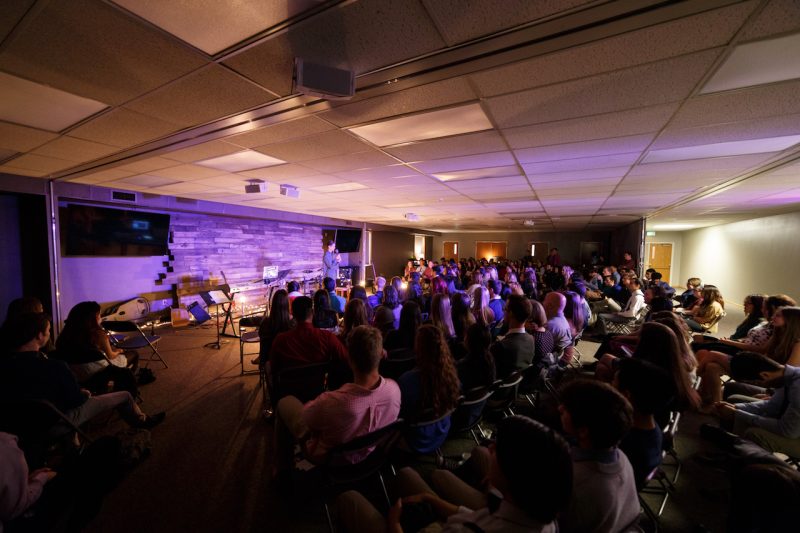Volunteer-Proofing A/V/L Systems
By Anthony Coppedge
There may not be any other vertical markets that use volunteers for mission-critical technical operations as much as churches. These well-intentioned, good-hearted volunteers are often put in charge of entire weekend service audio, video or lighting with often-minimal training and zero professional experience. The systems that are being installed into local churches are becoming more complex and more powerful, adding to the potential for the metaphorical train-wrecks of church services and events.
Higher Expectations
Church leaders and attendees alike are treated to excellent audio, video and lighting from myriad sources, from their own living rooms to concerts to movie theaters to large special events in their towns. This experience has led to an expectation that the “technology” surely must exist that can make their church’s auditoriums, halls and large group rooms look, sound and feel just as impressive.
Frankly, the church market has traditionally suffered from a double-edged sword of poorly designed systems and inadequately trained volunteers and staff. More recently, the quality of the systems has increased (along with an overall decrease in cost), but the results are often still hit-or-miss.
Keeping staff trained and updated is challenging enough for an integrator or manufacturer, let alone the prospect of training a seemingly ever-changing sea of volunteers. Even the largest churches (termed Mega Church, with weekly attendance greater than 2,000) rely heavily on training a small army of volunteers to fulfill all of the technical roles in addition to any full- or part-time staff or contracted professionals.
Lowering expectations is clearly not an option, so that leaves a few other solutions to help address the need.
More Training, More Often
In what is often a commodity price race to the bottom, the A/V/L industry has long found ways to add margin and profitability to the bottom line. Design fees, installation labor, service contracts and rentals are good additional services and streams of revenue. In addition, the opportunity to sell training to churches — or even groups of churches at a time — is somehow still missing from the profit equation.
Some reading will surely object, citing the oft-used phrase “churches don’t have money for that.” That’s almost correct. Churches often don’t have the cash up-front to add additional services at the time of sale or installation. But churches have been doing recurring revenue far longer than the Software As A Service (SaaS) folks have been in existence!
By amortizing the cost of additional services through simple monthly payments on a training contract, churches often can afford the additional expense. Further, the ability to spread training out over a long period of time will yield both better consistency and a more satisfied client. These can even be use-it-or-lose-it contracts, meaning that the church leadership is more likely to ensure consistent participation so that their payment isn’t wasted.
I’ve said it before here on rAVe, but it bears repeating: Manufacturers and integrators have got to think about how to provide real-world training to this vertical market.
Complex and Simple
The brilliant Alan Kay (famous for his computer language work and graphical user interfaces) said it best: “Simple things should be simple, complex things should be possible.” I can’t overstate the number of times that I’ve been in any number of venues — church, business, education, government — where even basic operation of the A/V/L technology was either cryptic or ambiguous. Look, we understand that making any number of systems work seamless together is complex. But as the venerable Mr. Kay pointed out, even complex systems should be possible to function in a relatively uncomplicated way.
If I may, allow me to share a design philosophy for churches: as much as it is possible, volunteer-proof the systems. I’ve heard some say “idiot proof” systems and processes, but I don’t think it’s smart or even reasonable to assume the worst in people. If anything, I’ve had to do more “un-training” with professionals who were taught incorrectly than I’ve ever had to do with volunteers.
Volunteer-proofing is not just simplifying; it’s designing around the reality of any situation where you will not have consistent operators for every event or venue. It also means the opportunity is afforded for users to get basic functionality out of a system or tool without an advanced engineering degree.
Years ago I had the privilege of visiting with Tim Jenison of NewTek, famed inventor of the “desktop video revolution,” and working with him on re-thinking the workflow of a new device he was creating. Part of his genius was to not stop at the design of the hardware but think through the software and firmware, too. A simple solution was to create a Graphical User Interface (GUI) that could be loaded based on the technical level of the operator. Thus, terms that were foreign to a non-industry veteran would be given more consumer-oriented terms for operational functions. In this way, the device could serve in the church market where volunteers would be the largest base of users for the device and the learning curve was much, much shorter due to common terminology and intuitive control functionality.
Simple Control Options
If you’re old enough to remember the Universal Remote Control that brought the living room electronics in one device, you’ll recall the frustration of various manufacturers creating proprietary IR controls with obscure or highly specific buttons. The Universal Remote sought to remedy the issue, but it didn’t always work. This third-party device was created in response to a problem, but it didn’t really address the problem; it only tried to overcome the problem.
My work in the A/V/L industry across multiple vertical markets has shown me the simple truth that people are people, so we’ll continue to have the vast majority of users be underqualified to operate even relatively simple equipment. It doesn’t matter if they’re corporate, government, education, non-profit or church clients; people are people and, as such, they’re going to be in every vertical market.
I can’t stress this enough: In most churches, the controls need to be practical and obvious; the training needs to be a unified effort on behalf of the industry. ICIA and AES and LDI all offer training, albeit targeting installers; why not vertical market training at the association level?
Happier Clients
Part of the sales process needs to be educating the church on defining the need and determining the expectation. Obvious, I know, but there have been so many projects where the church doesn’t want more gear; they simply want to use what they were originally sold.
The goal of every growing company is to have a combination of recurring business and new business from referrals. What better way to have a happy client than to provide the options for consistent training, helping define expectations and providing targeted resources for vertical market buyers?
There may be some reading this that might be inclined to point the finger at “the other guy,” whether it’s a competitor, a manufacturer or even the client. Your competitor isn’t you, and you can choose your manufacturers. The truth is this: The client isn’t always right, but you’d better not treat them like they’re wrong. Understand them, educate them and provide long-term service and training to keep them coming back and sharing your work with their friends. It’s not quick, but it’s a lot easier than finding new clients because you’re missing out on referrals.
A former staff member at three mega churches and church technology consultant, Anthony Coppedge has developed a respected reputation as a leader in technical and communications circles within the church marketplace. Reach him at anthony@anthonycoppedge.com or on Twitter athttp://www.twitter.com/anthonycoppedge






